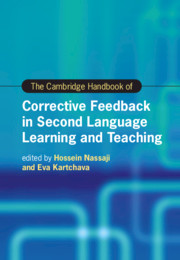Book contents
- The Cambridge Handbook of Corrective Feedback in Second Language Learning and Teaching
- Cambridge Handbooks in Language and Linguistics
- The Cambridge Handbook of Corrective Feedback in Second Language Learning and Teaching
- Copyright page
- Contents
- Figures
- Tables
- Contributors
- Acknowledgments
- Introduction Corrective Feedback in Second Language Teaching and Learning
- Part I Theoretical Perspectives on Corrective Feedback
- Part II Methodological Approaches in the Study of Corrective Feedback
- Part III Different Delivery Modes of Corrective Feedback
- Part IV Feedback Provider, Feedback Intensity, and Feedback Timing
- Part V Corrective Feedback and Language Skills
- Part VI Contexts of Corrective Feedback and Their Effects
- Part VII Learners’ and Teachers’ Feedback Perspectives, Perceptions, and Preferences
- 26 Teachers’ and Students’ Beliefs and Perspectives about Corrective Feedback
- 27 Written Corrective Feedback and Learners’ Objects, Beliefs, and Emotions
- 28 The Role of Training in Feedback Provision and Effectiveness
- 29 Perceptions and Noticing of Corrective Feedback
- Part VIII Individual Differences, Tasks, and Other Language- and Learner-Related Factors
- Index
- References
28 - The Role of Training in Feedback Provision and Effectiveness
from Part VII - Learners’ and Teachers’ Feedback Perspectives, Perceptions, and Preferences
Published online by Cambridge University Press: 26 February 2021
- The Cambridge Handbook of Corrective Feedback in Second Language Learning and Teaching
- Cambridge Handbooks in Language and Linguistics
- The Cambridge Handbook of Corrective Feedback in Second Language Learning and Teaching
- Copyright page
- Contents
- Figures
- Tables
- Contributors
- Acknowledgments
- Introduction Corrective Feedback in Second Language Teaching and Learning
- Part I Theoretical Perspectives on Corrective Feedback
- Part II Methodological Approaches in the Study of Corrective Feedback
- Part III Different Delivery Modes of Corrective Feedback
- Part IV Feedback Provider, Feedback Intensity, and Feedback Timing
- Part V Corrective Feedback and Language Skills
- Part VI Contexts of Corrective Feedback and Their Effects
- Part VII Learners’ and Teachers’ Feedback Perspectives, Perceptions, and Preferences
- 26 Teachers’ and Students’ Beliefs and Perspectives about Corrective Feedback
- 27 Written Corrective Feedback and Learners’ Objects, Beliefs, and Emotions
- 28 The Role of Training in Feedback Provision and Effectiveness
- 29 Perceptions and Noticing of Corrective Feedback
- Part VIII Individual Differences, Tasks, and Other Language- and Learner-Related Factors
- Index
- References
Summary
This chapter addresses the topic of training in corrective feedback. The chapter discusses the role and importance of training and also how feedback training can assist feedback provision and processing. To this end, empirical studies on both teacher and student training of feedback and their implications are discussed. This discussion is limited to oral corrective feedback, since much of the research on feedback training concerns oral feedback. Pedagogical implications as well as directions for future investigations are also discussed.
Keywords
- Type
- Chapter
- Information
- The Cambridge Handbook of Corrective Feedback in Second Language Learning and Teaching , pp. 598 - 619Publisher: Cambridge University PressPrint publication year: 2021
References
- 3
- Cited by

